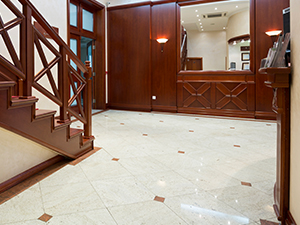Considerations for Mixed Stone Installations
The highest concern of natural stone installers and designers is to make sure your natural stone floors, walls, countertops, or other applications look great and are installed correctly. They often don’t give much thought to what the stone might look like after traffic and use have taken a toll. As natural stone restoration contractors, we sometimes get calls from home or business owners who want us to refinish their kitchens, baths, or other areas that have soft stones like marble or travertine with hard stone inlays, such as granite. These clients are frequently surprised at the cost difference between refinishing a single stone versus refinishing a design that incorporates several types of stone. In addition, people who have combination finishes, for example a floor with some parts honed and some parts polished, run into the same situation. This article explains the reasons behind the price differences and also provides some suggestions to people who are considering utilizing more than one type of stone or one type of finish in a new installation.
Time = Money
We reached out to Fred Hueston, world-renowned natural stone expert, author of many books, instructional videos, and articles on stone installation, care, and restoration in the U.S. and abroad, and Chief Technical Director for surpHaces. He explains why mixed stone surfaces require more time to restore than single stone surfaces:
The reason for this can be a little confusing to the average client. There are diamonds made for honing and polishing marble and others specifically for granite. Some diamond pad manufactures now have combination diamonds that can be used on both. But the price difference has to do with time, not diamond cost.
For example, granite is going to take four or five times as long to refinish and polish than marble. The contractor may opt to tape off the granite, refinish the marble with one set of diamonds, and then tape off the marble and refinish the granite with another set of diamonds. If the contractor uses a diamond pad that can restore both marble and granite to refinish the entire area all at once, the amount of time spent on the floor must be based on the granite, not the marble. In certain circumstances, only the marble is refinished, because the granite is in much better condition than the marble. Even so, the granite portions of the surface will need to be taped off.
Suggestions for New Installations With Stone Combinations
We also asked Hueston what kinds of stone combinations he would recommend for people who have their hearts set on utilizing more than one kind of stone in their design. He said,
Obviously, using different colors of one type of stone would be good, for example, black marble with white marble. If you are going to use different types of stone, they need to match in hardness. So, generally marble, onyx, and limestone can be combined and then later restored or refinished with little or no price difference from a single-stone application.
Combination Finishes
Home and business owners also can expect to see a price difference to have combination finishes restored. A honed finish must be achieved first, and then the portion of the surface that should remain a honed finish must be taped off before the polished portion of the surface can be restored. This takes extra time than just achieving a single finish for the entire surface. However, there should be no price difference if you want to go from a combination finish to a single finish. If you are having new stone installed, you must either go with a single finish or be willing to pay a little bit more to maintain the appearance of a combination finish.
This is one of a series of articles written and published on behalf of surpHaces Partners.

